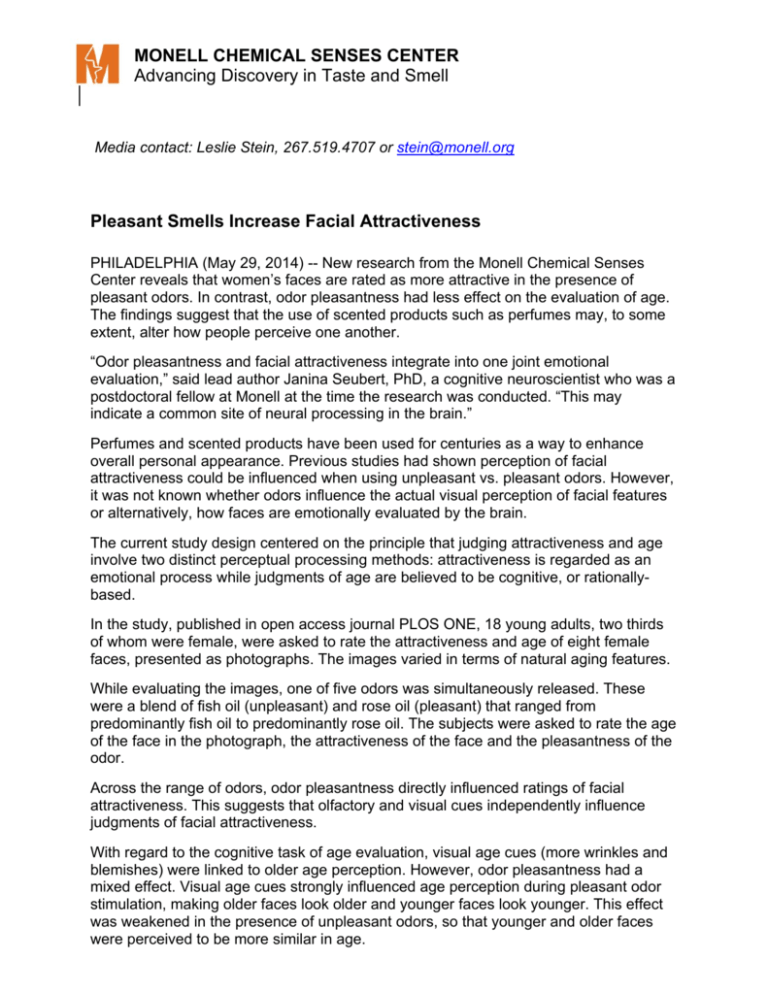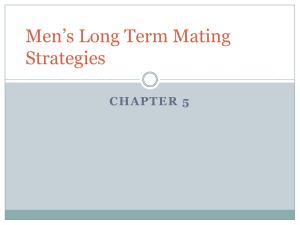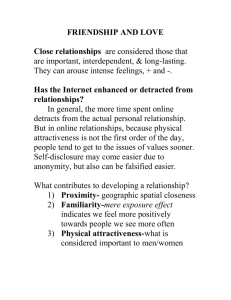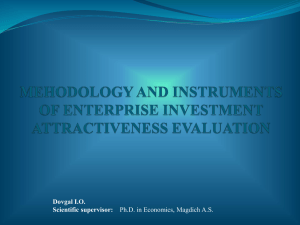as a PDF - Monell Chemical Senses Center
advertisement

MONELL CHEMICAL SENSES CENTER Advancing Discovery in Taste and Smell Media contact: Leslie Stein, 267.519.4707 or stein@monell.org Pleasant Smells Increase Facial Attractiveness PHILADELPHIA (May 29, 2014) -- New research from the Monell Chemical Senses Center reveals that women’s faces are rated as more attractive in the presence of pleasant odors. In contrast, odor pleasantness had less effect on the evaluation of age. The findings suggest that the use of scented products such as perfumes may, to some extent, alter how people perceive one another. “Odor pleasantness and facial attractiveness integrate into one joint emotional evaluation,” said lead author Janina Seubert, PhD, a cognitive neuroscientist who was a postdoctoral fellow at Monell at the time the research was conducted. “This may indicate a common site of neural processing in the brain.” Perfumes and scented products have been used for centuries as a way to enhance overall personal appearance. Previous studies had shown perception of facial attractiveness could be influenced when using unpleasant vs. pleasant odors. However, it was not known whether odors influence the actual visual perception of facial features or alternatively, how faces are emotionally evaluated by the brain. The current study design centered on the principle that judging attractiveness and age involve two distinct perceptual processing methods: attractiveness is regarded as an emotional process while judgments of age are believed to be cognitive, or rationallybased. In the study, published in open access journal PLOS ONE, 18 young adults, two thirds of whom were female, were asked to rate the attractiveness and age of eight female faces, presented as photographs. The images varied in terms of natural aging features. While evaluating the images, one of five odors was simultaneously released. These were a blend of fish oil (unpleasant) and rose oil (pleasant) that ranged from predominantly fish oil to predominantly rose oil. The subjects were asked to rate the age of the face in the photograph, the attractiveness of the face and the pleasantness of the odor. Across the range of odors, odor pleasantness directly influenced ratings of facial attractiveness. This suggests that olfactory and visual cues independently influence judgments of facial attractiveness. With regard to the cognitive task of age evaluation, visual age cues (more wrinkles and blemishes) were linked to older age perception. However, odor pleasantness had a mixed effect. Visual age cues strongly influenced age perception during pleasant odor stimulation, making older faces look older and younger faces look younger. This effect was weakened in the presence of unpleasant odors, so that younger and older faces were perceived to be more similar in age. Jean-Marc Dessirier, Lead Scientist at Unilever and a co-author on the study said, “These findings have fascinating implications in terms of how pleasant smells may help enhance natural appearance within social settings. The next step will be to see if the findings extend to evaluation of male facial attractiveness.” The paper can be accessed at http://dx.plos.org/10.1371/journal.pone.0098347. Also contributing to the research, which was funded by Unilever, were senior author Johan Lundström and Kristen Gregory of Monell, and Jessica Chamberland of Unilever. Seubert is currently at the Karolinska Institute. ### About Monell The Monell Chemical Senses Center is an independent nonprofit basic research institute based in Philadelphia, Pennsylvania. For over 45 years, Monell has advanced scientific understanding of the mechanisms and functions of taste and smell to benefit human health and well-being. Using an interdisciplinary approach, scientists collaborate in the programmatic areas of sensation and perception; neuroscience and molecular biology; environmental and occupational health; nutrition and appetite; health and wellbeing; development, aging and regeneration; and chemical ecology and communication. For more information about Monell, visit www.monell.org. About Unilever R&D Unilever R&D involves over 6,000 professionals, six strategic centres for global R&D and 31 major product development centres. The strategic centres are located in Trumbull, US, Port Sunlight and Colworth in the UK, Vlaardingen in The Netherlands, Bangalore in India and Shanghai in China. In 2013, investment in R&D was around €1bn.








